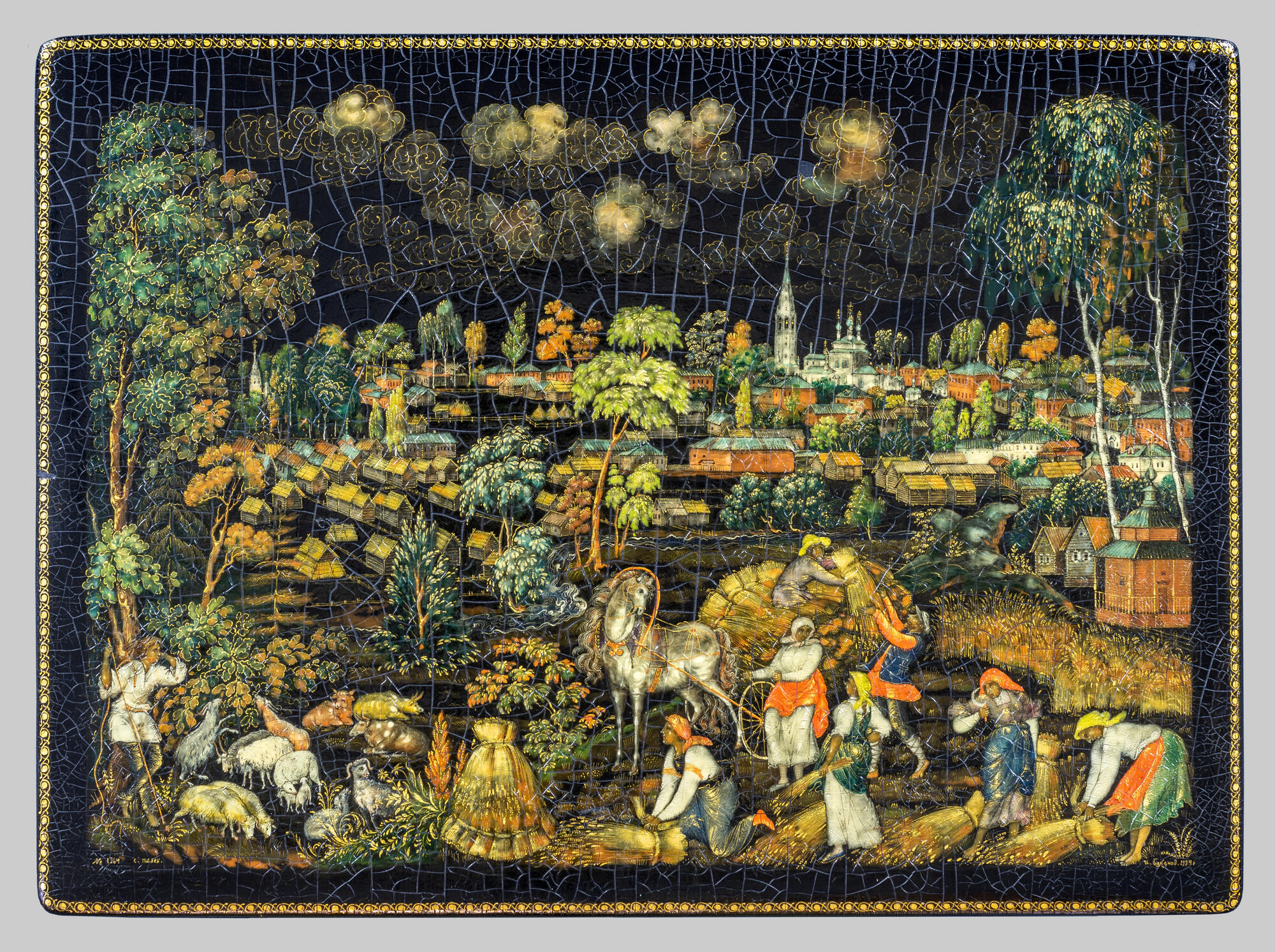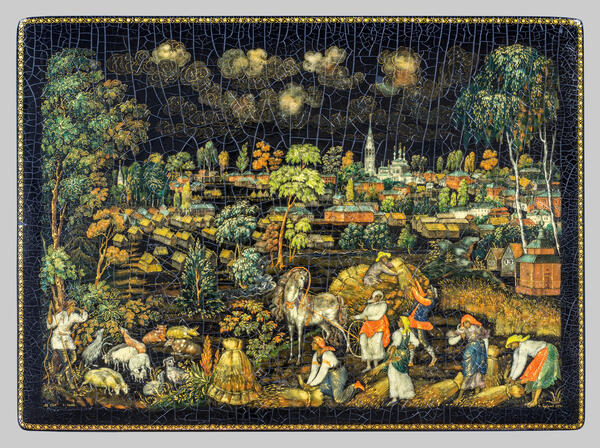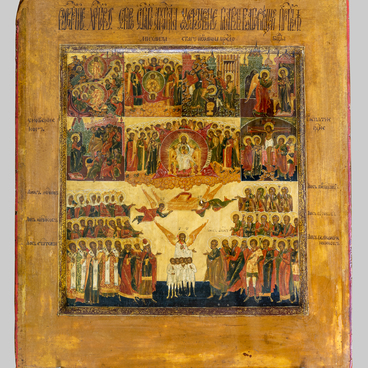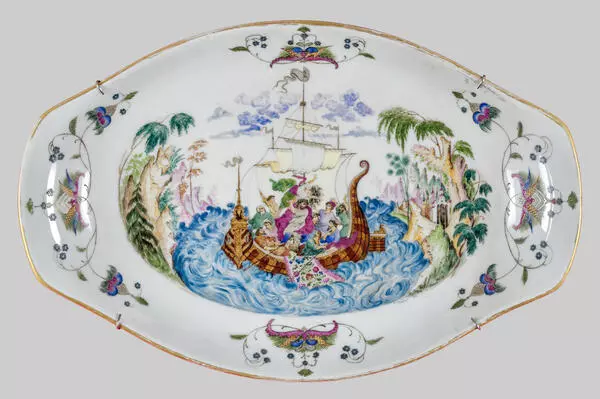Ivan Bakanov created the ‘Palekh Village’ composition in 1934. He was among the first artists to depict the locales he was raised in lacquer miniature. The image of the Old Palekh then went on to become the theme favored by many artists in their creative work. Stylized landscape, scenes of labor and recreation against the backdrop of nature reflected the daily lives of locals. They demonstrated the most important thing in the Palekh art — people who live in harmony with the world around them.
The art of Palekh is born out of icon painting. Many of the peculiarities and techniques from the latter have stuck around. The conventional language derived from the icon painting tradition did not, however, hamper the artist’s efforts to truthfully capture the image of his home village. The landscapes with “leshchadkas” and “cremeshki” (these Russian words describe the hill slopes in icon painting) that were previously the staple of landscape painting for icons were now transformed by Ivan Bakanov to the hills and glades with birches and pines which he loved from the bottom of his heart.
The artist did not limit himself to depicting just one end of Palekh. He depicted the whole village, as if he had a bird’s eye view on it. The landscape of the locale is true to life, and so are the buildings. In the center of the composition, the Paleshka river winds in whimsical bends. The hipped bell tower of the local temple, surrounded by wooden log cabins, stretches upward. At the other end of the village, one can see the Ilyinskaya cemetery church among the curly birches.
The dark color of the sky in the miniature does not make it gloomy — on the contrary, it seems to make the glow of sunbeams brighter. This background is an important trait of the Palekh style. Colorful silhouettes on a black background seem more expressive, and the colors more vivid.
Ivan Bakanov used his custom moves to paint the landscape. Nikolai Zinoviev, another Palekh artist, described Ivan’s painting manner: “…he did not paint the landscape in general tones, but painted as if from life, in different colors, fusing them into each other without edges, merging them imperceptibly.” Another unusual move in artist’s arsenal: painting the edges of the earth with gold.
Specialists note that perhaps the artist painted himself as one of the characters in the miniature. Members of the Artel of Ancient Painting took an active part in the summer harvest, working in the ‘Red Palekh’ collective farm. This way, the artist could’ve highlighted the connection the residents of Palekh had to the world of nature, and the artist believed himself to be a part of that world, too.
Ivan Bakanov’s miniature is remarkable not only in his personal legacy, but in the art heritage of Palekh as a whole.
The art of Palekh is born out of icon painting. Many of the peculiarities and techniques from the latter have stuck around. The conventional language derived from the icon painting tradition did not, however, hamper the artist’s efforts to truthfully capture the image of his home village. The landscapes with “leshchadkas” and “cremeshki” (these Russian words describe the hill slopes in icon painting) that were previously the staple of landscape painting for icons were now transformed by Ivan Bakanov to the hills and glades with birches and pines which he loved from the bottom of his heart.
The artist did not limit himself to depicting just one end of Palekh. He depicted the whole village, as if he had a bird’s eye view on it. The landscape of the locale is true to life, and so are the buildings. In the center of the composition, the Paleshka river winds in whimsical bends. The hipped bell tower of the local temple, surrounded by wooden log cabins, stretches upward. At the other end of the village, one can see the Ilyinskaya cemetery church among the curly birches.
The dark color of the sky in the miniature does not make it gloomy — on the contrary, it seems to make the glow of sunbeams brighter. This background is an important trait of the Palekh style. Colorful silhouettes on a black background seem more expressive, and the colors more vivid.
Ivan Bakanov used his custom moves to paint the landscape. Nikolai Zinoviev, another Palekh artist, described Ivan’s painting manner: “…he did not paint the landscape in general tones, but painted as if from life, in different colors, fusing them into each other without edges, merging them imperceptibly.” Another unusual move in artist’s arsenal: painting the edges of the earth with gold.
Specialists note that perhaps the artist painted himself as one of the characters in the miniature. Members of the Artel of Ancient Painting took an active part in the summer harvest, working in the ‘Red Palekh’ collective farm. This way, the artist could’ve highlighted the connection the residents of Palekh had to the world of nature, and the artist believed himself to be a part of that world, too.
Ivan Bakanov’s miniature is remarkable not only in his personal legacy, but in the art heritage of Palekh as a whole.






